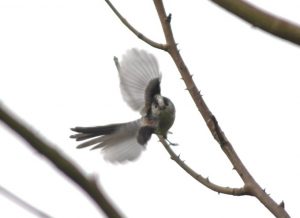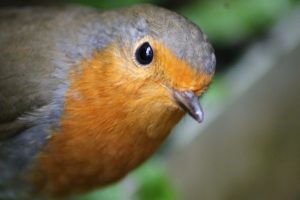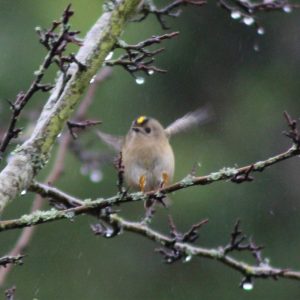By Andy Winfield

As long as there have been gardens there have been birds in gardens; as gardeners we’re continuing the long relationship that will ever end. There may be some ups and downs, pigeons pecking seedlings or fruit bushes stripped; but on the whole gardeners and garden birds have a bond that goes deep. Here’s how I see some of the birds that visit the Botanic Garden.
A good population of birds is a sign that there is a good diversity of insects. Blue, great and long tailed tits enjoy spiders, larva and other small insects, and they go where the food is; all three of these birds are present in numbers in the Garden. Encourage insects and you’ll encourage birds. These small residents are a pleasure to be around, always busy and seemingly in the middle of doing something very important.
Goldfinches fly around in small groups, their tough beaks picking out protein rich seeds of teasel; the books describe their sound as ‘a liquid twitter’, which is wonderful. They pour the sound liberally wherever they go, flashes of yellow and red accompany the movement.
Blackbirds will sing the most beautiful song, begrudgingly beautiful at four in the morning in the middle of summer; they will also panic at every sunset seeming to forget that one happened only the day before.

Robins follow the gardener around; we are, to a robin, performing the same task that wild boar did in the woodlands of the past. Grubbing up the ground to reveal worms, millipedes and other insects; they’re like the oxpecker bird, or the cleaner fish of the garden, following us around and making use of our work. Of course they can also sing a good song. If life gives you a singing robin, watch the singing robin; for that moment nothing else exists but full bodied music ringing through the wintry air.
Crows get a bad rap, but I really like them. They’re companions in winter with croaky cawing from a tree; they put everything into their caw, and don’t have a robin’s octaves, but they definitely get points for trying! Crows hop around going about their business in an intelligent way, always figuring something out, as if they’re heading back to the nest to discuss a point of science with their friends. They know what’s going on do crows; when the dragonflies emerge from the pool, when a heron is planning a raid on their nests, and, I think, they sussed out the theory of gravity thousands of years before us.

Goldcrests are the smallest of our birds and one of my favourite; they’re constantly on the move but stay around yew trees in the Botanic Garden, inspecting each twig individually for the tiny insects that they feed on and chatting to themselves all the while. Their noise is quiet and high pitched, and I read that as we get older our ability to hear it disappears; this hasn’t happened to me yet, so in the mean time I’m going to listen to them as much as possible so I never forget.
Every now and then a sparrow hawk visits the Botanic Garden; I can tell when it’s there because all other bird talk stops. Like a police car on the motorway that never encounters anyone speeding around it, a sparrow hawk must think that there’s no such thing as other birdsong; everywhere it goes must be quiet. These birds are incredibly agile and I once saw it on the chase; it and the bird it was after seemed to fly up the wall of a house before tracing the contour of the roof and disappearing over the other side. It was one second long, but got my heart racing. It’s no wonder the birds keep their beaks shut when they’re around.
This is a glimpse of the interactions we have with birds in the Botanic Garden; it’s a deep and wholesome relationship that of the gardener and garden bird, and I’m sure many of you reading this will have your own experiences. They’re a vital component of a garden’s existence and will be for as long as we have gardens. Simply by putting plants in the ground, looking after trees and having a lawn we are prolonging our friendship, and long may it continue.

